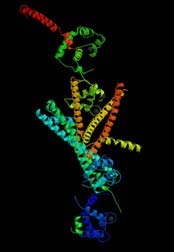New Standard to Help Diagnose Heart Attacks

crystal structure of the human protein cardiac troponin. <br>Graphic Courtesy Protein Data Bank
Diagnosing heart attacks will become a more precise science thanks to the first of a new series of clinical standards just issued by the National Institute of Standards and Technology (NIST). Standard Reference Material (SRM) 2921 (human cardiac troponin complex) will help manufacturers develop and calibrate assays that measure specific protein concentrations in patient blood samples to determine whether a heart attack has occurred.
The SRM is a solution containing certified concentrations of three related proteins, including cardiac troponin I, purified from human heart tissue from cadavers. Users can calibrate their assays by analyzing the SRM and comparing the results to the NIST-certified value for troponin I. The standard is expected to help reduce variations in clinical test results from as much as 50-fold on the same sample to just twofold. “It’s a big first step toward getting the system under control,” says Michael Welch, leader of the NIST development team.
NIST already produces more than 60 SRMs for the clinical diagnostics community, but this is the first one designed to help measure concentrations of large, protein-based health status markers. Troponin I is difficult to measure because it can exist in low concentrations and in different chemical forms, sometimes attached to other related proteins. NIST is developing additional standards and methods for measuring other health status indicators of this type, including hormones used to assess thyroid function, and other markers for heart attack risk such as homocysteine and C-reactive protein.
SRM 2921 is intended to help U.S. makers of in vitro diagnostic (IVD) medical devices sell their products in Europe. A European Union directive requires that such devices be calibrated with standards that are traceable to internationally recognized certified reference materials or procedures. SRM 2921 has been nominated for inclusion on the international list of higher order reference materials. The list currently contains approximately 150 entries for 96 health status markers; NIST SRMs provide traceability for 72 of these.
Media Contact
More Information:
http://www.nist.gov/public_affairs/techbeat/tb2004_0524.htmAll latest news from the category: Health and Medicine
This subject area encompasses research and studies in the field of human medicine.
Among the wide-ranging list of topics covered here are anesthesiology, anatomy, surgery, human genetics, hygiene and environmental medicine, internal medicine, neurology, pharmacology, physiology, urology and dental medicine.
Newest articles

Superradiant atoms could push the boundaries of how precisely time can be measured
Superradiant atoms can help us measure time more precisely than ever. In a new study, researchers from the University of Copenhagen present a new method for measuring the time interval,…

Ion thermoelectric conversion devices for near room temperature
The electrode sheet of the thermoelectric device consists of ionic hydrogel, which is sandwiched between the electrodes to form, and the Prussian blue on the electrode undergoes a redox reaction…

Zap Energy achieves 37-million-degree temperatures in a compact device
New publication reports record electron temperatures for a small-scale, sheared-flow-stabilized Z-pinch fusion device. In the nine decades since humans first produced fusion reactions, only a few fusion technologies have demonstrated…





















